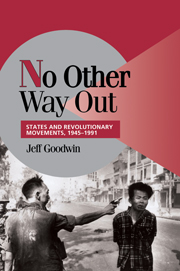Book contents
- Frontmatter
- Contents
- Figures, Tables, and Maps
- Abbreviations and Acronyms
- Preface and Acknowledgments
- Part 1 Introduction
- 1 COMPARING REVOLUTIONARY MOVEMENTS
- 2 THE STATE-CENTERED PERSPECTIVE ON REVOLUTIONS: STRENGTHS AND LIMITATIONS
- Part 2 Southeast Asia
- Part 3 Central America
- Part 4 Further Comparisons and Theoretical Elaborations
- Annotated Bibliography
- Index
- Titles in the series
1 - COMPARING REVOLUTIONARY MOVEMENTS
Published online by Cambridge University Press: 05 June 2012
- Frontmatter
- Contents
- Figures, Tables, and Maps
- Abbreviations and Acronyms
- Preface and Acknowledgments
- Part 1 Introduction
- 1 COMPARING REVOLUTIONARY MOVEMENTS
- 2 THE STATE-CENTERED PERSPECTIVE ON REVOLUTIONS: STRENGTHS AND LIMITATIONS
- Part 2 Southeast Asia
- Part 3 Central America
- Part 4 Further Comparisons and Theoretical Elaborations
- Annotated Bibliography
- Index
- Titles in the series
Summary
Scholars have offered some interesting theories on how revolution develops and why it develops, but they have generally failed to explain how similar elements have produced revolutions in some cases and not in others. Research in the field should begin to examine “failed revolutions” and “revolutions that never took place” as well as successful ones to determine the revolutionary element or elements.
– William E. Lipsky (1976: 508)Revolutionary movements are not simply or exclusively a response to economic exploitation or inequality, but also and more directly a response to political oppression and violence, typically brutal and indiscriminate. This is the principal thesis of this book, one that I reach through an examination of revolutionary movements that emerged during the second half of what has been called the “short” twentieth century (1914–91), a period characterized by the Cold War between the United States and the former Soviet Union.
The Cold War era (1945–91) was truly an “age of revolution,” even more so, arguably, than the great revolutionary age of 1789–1848 (see Hobsbawm 1962). Dozens of powerful revolutionary movements emerged across the globe during this period, mainly in the Third World, and a number of them successfully overthrew existing political authorities. In the process, some movements also radically restructured, destroyed, or replaced key institutions, social relationships, and shared beliefs.
- Type
- Chapter
- Information
- No Other Way OutStates and Revolutionary Movements, 1945–1991, pp. 3 - 34Publisher: Cambridge University PressPrint publication year: 2001
- 1
- Cited by



